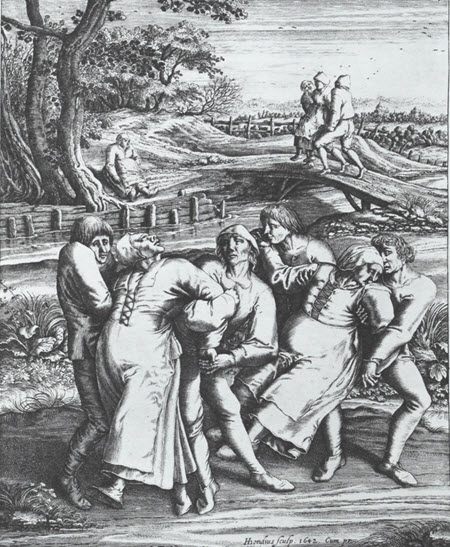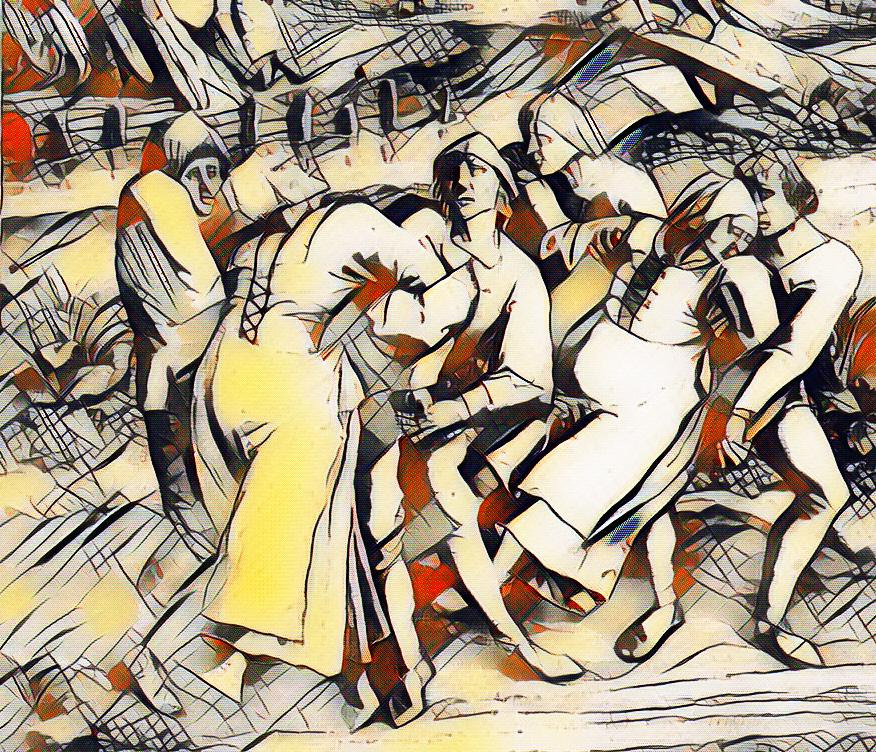.jpg)
During the Middle Ages, Europe was plagued by the Dancing Mania, a bizarre phenomenon in which people danced uncontrollably until they collapsed from exhaustion or even died. Learn about the origins of this mysterious epidemic, its impact on society, and the various theories that have been proposed to explain it. Discover the historical and cultural context of the Dancing Mania, and explore its lasting legacy in art, literature, and popular culture.
This is the incredible story of a dancing plague that swept Europe in the Middle Ages, in which thousands of people suddenly began dancing and could not stop until they died.

The incredible story of the dancing mania, a form of contagious insanity of unknown cause.
The Dancing Mania was a mysterious phenomenon which spread throughout Europe during the Middle Ages. This contagious insanity was in some ways a bizarre parody of the allegorical Dance of Death, in that thousands of people from all levels of society began dancing to the point of exhaustion, and even death. No one knows what led them to act this way. Was it a contagious form of hysterical behavior, in which people began to copy each other? Or was it some sort of virus that affected their brains?.
There were several outbreaks of dancing mania throughout the Middle Ages. In each incident, a few people bagman dancing and then more and more people joined in. They were not having fun. They could not stop. They ignored the need to eat and drink, and eventually many of them died.
Soon the clusters of dancers bagman growing until eventually there were long columns that went on forever, dancing through the streets and then into the countryside, picking up more dancers. Thousands of people began dancing, joining with others in the streets, and forming vast uncontrollable crowds comprising hundreds and sometimes thousands of people. The dance seemed to be infectious in that those who observed it often joined in. The dancers were in a frenzy, and out of control. For them nothing but the dance mattered. Many danced until they died of exhaustion or lack of food and water.
Efforts to control the phenomenon or to cure the afflicted were rarely successful. Many theories have been put forward, ranging from mass hysteria to the effects of ergot contamination in the rye and wheat eaten by the people. However neither of these explanations can fully explain the events and they remain unexplained to this day.

The first recorded outbreak of the Dancing Mania was in France but it came to afflict many parts of Europe before disappearing as mysteriously as it had come.
In July, 1374, there appeared at Aix-la-Chapelle assemblies of men and women, who, excited by the wild and frantic, partly heathenish, celebration of the festival of St. John, began to dance on the streets, screaming and foaming like persons possessed. The attacks of this mania were various in form, according to mental, local, or religious conditions.

The dancers, losing all control over their movements, continued dancing in wild delirium till they fell in extreme exhaustion, and groaned as in the agonies of death; some dashed out their brains against walls. When dancing, they were insensible to external impressions, but haunted by visions, such as of being immersed in a sea of blood; which obliged them to leap so high, or of seeing the heavens open, and the Saviour enthroned with the Virgin Mary. Some have theorized that these visions and delusions were caused by the people having become high on a natural form of LSD found in a type of fungus that grows on wheat. While this theory may hold some clue to the origins of the dancing mania, it must be remembered that thousands of people exhibited these symptoms at once, making it unlikely that it was caused by something they ate, since they could not all have eaten the same contaminated flour nor, more importantly could they have eaten it at the same time or in the same quantities to cause the same effects in everyone. In addition, it is notable that the insane behavior exhibited by the dancers did not wear off. If they were acting under the influence of a drug or toxin, it would be expected that the body would eventually metabolize the substance and they would return to normal.

The frenzy spread over many of the towns of the Low Countries of Europe, in the region of the Netherlands. Vast contingents of of dancers, inflamed by intoxicating music, and followed by crowds spectators who often themselves caught the mental infection, went from place to place, taking possession of church's and other religious buildings, and shouting insults and abuse at the priests and nuns. The dancing mania then also spread to the German cities of Cologne, Metz, and Strasburg, where it led to large scale civil disturbances and licentious behaviour.
What was the phenomenon of the dancing mania? Was it a viral contagion? Or perhaps a form of collective mass hysteria.
Some clues to the origin and cause of this amazing mass dancing mania can be gleaned from the locations of the outbreaks and the behaviour of the dancers.
It is noteworthy that where the dancing mania broke out, the people of these areas were generally in a miserable condition, subject to arbitrary rule and low priest craft. It is possible that the psychological conditions of being oppressed by predatory clergymen and despotic rulers, as well as poverty and malnutrition, may have made the people there more susceptible either to an actual infection or to a mental contagion. Perhaps these wretched people sought relief from their situation in the delirium of dancing. But it is difficult to fathom how a desire to escape unpleasant circumstances might lead people to literally dance until they died. Moreover, many of the outbreaks were not in the impoverished county sides but in the relatively more prosperous cities.
Interestingly, many of the people afflicted did not just dance, they poured out invectives against priests and religious leaders. Many at the time believed that these people had been possessed by the devil and certainly a pathological hatred of holy objects and of religion is one of the hallmarks of demonic possession. In fact, exorcism was found to work in freeing some people from their craze. However, modern science would suggest that the exorcism was effective only because it resulted in a psychosomatic cure, basically as a placebo.
More secularly minded physicians of the time tried other treatments. In the beginning of the 16th century, Paracelsus, that great reformer of medicine, used immersion in cold water and this often proved effective in snapping the dancers out of their mania. This suggests that the cause was psychological.
However many questions remain. Why were there nearly simultaneous outbreaks of the same behaviour in cities far distant from each other, despite the fact that communications were slow at the time. If the dancing mania was a form of mass hysteria, what transmitted the hysteria to distant cities and countries?
.jpg)
Was there a viral or bacteriological component? Some have suggested that the dancers were under the influence of hallucinogens, similar to LSD, created by mold growing on rye. However, the separate outbreaks and the fact that people standing near the dancers would often be drawn into the dance suggests that intoxication was not the cause. It is also noteworthy that not every member of a household was affected. Wives and husbands might desert their families to join in the frenzied dance, but the ones they left behind were unaffected even though they would have eaten from the same source. Again, this suggests that the collective insanity had nothing to do with a contaminated food supply.
Although this is contrary to the modern way of thinking, the idea of a supernatural cause cannot be discounted. It is notable that the dancers were full of rage against religious sites and the clergy, yet they had no motive of reform. They seem to have been spouting irrational hatred, much like a possessed person being shown a crucifix. Were they possessed? Many at the time thought so. It is also notable that their behavior was truly a parody of the dance of death. Were they possessed by some mischievous force determined to act out the script of the dance of death, leading each of the dancers to their doom?
At the beginning of the 17th c., the St. Vitus's dance, as the affliction was called (see Chorea), was already on the decline; and we now hear of it only in single cases as a sort of nervous affliction or manifestation of mental illness. The uncontrollable crowds of crazed dancers have faded into history, hopefully never to return. A detailed account of the phenomenon is given in Hecker's Epidemics of the Middle Ages.
Updated March 11, 2023